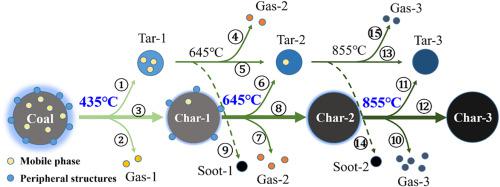当前位置:
X-MOL 学术
›
Fuel Process. Technol.
›
论文详情
Our official English website, www.x-mol.net, welcomes your feedback! (Note: you will need to create a separate account there.)
Effect of temperature on Shenfu coal pyrolysis process related to its chemical structure transformation
Fuel Processing Technology ( IF 7.5 ) Pub Date : 2021-03-01 , DOI: 10.1016/j.fuproc.2020.106662 Kai Xu , Song Hu , Liangping Zhang , Hanjian Li , Yifeng Chen , Zhe Xiong , Jun Xu , Long Jiang , Yi Wang , Sheng Su , Jun Xiang
Fuel Processing Technology ( IF 7.5 ) Pub Date : 2021-03-01 , DOI: 10.1016/j.fuproc.2020.106662 Kai Xu , Song Hu , Liangping Zhang , Hanjian Li , Yifeng Chen , Zhe Xiong , Jun Xu , Long Jiang , Yi Wang , Sheng Su , Jun Xiang

|
Abstract Revealing the pyrolysis reaction pathway related to coal structure evolution under different temperatures is important for the industry to design reactors and process operations. In this study, all the pyrolysis products obtained under different pyrolysis temperatures were comprehensively analyzed by multiple techniques. The results showed that the aromatic nucleus were inclined to react with methyl radicals, forming char with abundant methyl substitution aromatic structure at low pyrolysis temperature. At medium pyrolysis temperature, dramatically condensation reaction occurred, resulting in the formation of aromatic protonated carbon and abundant polycyclic aromatic hydrocarbons (PAHs) containing benzenoid rings joined by a carbon‑carbon single bond remaining in char. The concentration of aliphatic hydrocarbons in light tar decreased dramatically and converted into light hydrocarbon gas compounds (especially H2 and CH4). At high pyrolysis temperature, severe carbonation of char led to the formation of abundant PAHs with reduced aliphatic side chain in light tar. Tar precursors preferred to form larger PAHs due to occurrence of drastic secondary reaction. The contents and diversity of oxygen−/nitrogen-containing heteroatom compounds in heavy tar were significantly reduced with the increase of temperature. Finally, the devolatilization mechanism responsible for the evolution of chemical structure of Shenfu coal pyrolyzed at elevated temperatures was proposed.
中文翻译:

温度对神府煤热解过程及其化学结构转变的影响
摘要 揭示不同温度下与煤结构演化相关的热解反应途径对于工业设计反应器和工艺操作具有重要意义。本研究通过多种技术对不同热解温度下获得的所有热解产物进行综合分析。结果表明,芳核倾向于与甲基自由基反应,在低热解温度下形成具有丰富甲基取代芳香结构的炭。在中等热解温度下,发生剧烈的缩合反应,形成芳香质子化碳和丰富的多环芳烃(PAHs),其中含有苯环,碳碳单键保留在炭中。轻焦油中脂肪烃的浓度急剧下降并转化为轻烃气体化合物(尤其是 H2 和 CH4)。在高热解温度下,焦炭的严重碳酸化导致形成丰富的多环芳烃,轻焦油中脂肪族侧链减少。由于发生剧烈的二次反应,焦油前体更倾向于形成较大的多环芳烃。重焦油中含氧/氮杂原子化合物的含量和多样性随着温度的升高而显着降低。最后,提出了高温热解神府煤化学结构演变的脱挥发分机制。炭的严重碳酸化导致形成丰富的多环芳烃,轻焦油中脂肪族侧链减少。由于发生剧烈的二次反应,焦油前体更倾向于形成较大的多环芳烃。重焦油中含氧/氮杂原子化合物的含量和多样性随着温度的升高而显着降低。最后,提出了高温热解神府煤化学结构演变的脱挥发分机制。炭的严重碳酸化导致形成丰富的多环芳烃,轻焦油中脂肪族侧链减少。由于发生剧烈的二次反应,焦油前体更倾向于形成较大的多环芳烃。重焦油中含氧/氮杂原子化合物的含量和多样性随着温度的升高而显着降低。最后,提出了高温热解神府煤化学结构演变的脱挥发分机制。
更新日期:2021-03-01
中文翻译:

温度对神府煤热解过程及其化学结构转变的影响
摘要 揭示不同温度下与煤结构演化相关的热解反应途径对于工业设计反应器和工艺操作具有重要意义。本研究通过多种技术对不同热解温度下获得的所有热解产物进行综合分析。结果表明,芳核倾向于与甲基自由基反应,在低热解温度下形成具有丰富甲基取代芳香结构的炭。在中等热解温度下,发生剧烈的缩合反应,形成芳香质子化碳和丰富的多环芳烃(PAHs),其中含有苯环,碳碳单键保留在炭中。轻焦油中脂肪烃的浓度急剧下降并转化为轻烃气体化合物(尤其是 H2 和 CH4)。在高热解温度下,焦炭的严重碳酸化导致形成丰富的多环芳烃,轻焦油中脂肪族侧链减少。由于发生剧烈的二次反应,焦油前体更倾向于形成较大的多环芳烃。重焦油中含氧/氮杂原子化合物的含量和多样性随着温度的升高而显着降低。最后,提出了高温热解神府煤化学结构演变的脱挥发分机制。炭的严重碳酸化导致形成丰富的多环芳烃,轻焦油中脂肪族侧链减少。由于发生剧烈的二次反应,焦油前体更倾向于形成较大的多环芳烃。重焦油中含氧/氮杂原子化合物的含量和多样性随着温度的升高而显着降低。最后,提出了高温热解神府煤化学结构演变的脱挥发分机制。炭的严重碳酸化导致形成丰富的多环芳烃,轻焦油中脂肪族侧链减少。由于发生剧烈的二次反应,焦油前体更倾向于形成较大的多环芳烃。重焦油中含氧/氮杂原子化合物的含量和多样性随着温度的升高而显着降低。最后,提出了高温热解神府煤化学结构演变的脱挥发分机制。



























 京公网安备 11010802027423号
京公网安备 11010802027423号